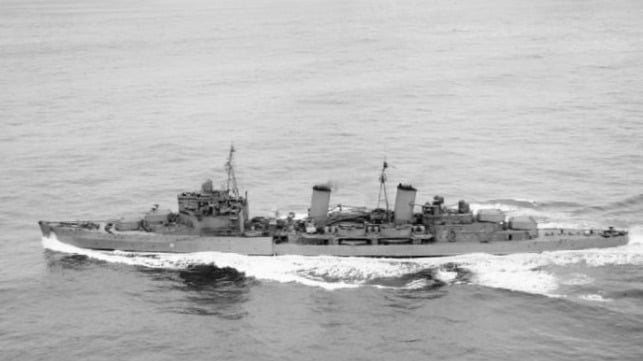Royal Navy Surveys Lost Vessels of WWII Arctic Convoys

Royal Navy survey ship HMS Echo recently returned to waters where sailors once faced Nazi bombers and U-boats to pay tribute to the first Arctic convoy 80 years ago.
The ship paused in the middle of the Barents Sea to remember the men of Operation Dervish and the thousands who followed them, delivering vital aid to the Soviet Union between 1941 and 1945.
Echo has been conducting survey work in the High North, including searching for the wreck of one sunken WW2 cruiser and updating existing information about another, HMS Edinburgh, over whose wreck Echo’s crew held a service of remembrance.
As Echo’s Commanding Officer Commander Adam Coles cast a wreath into the Barents Sea, the Russian cruiser Marshal Ustinov – which was sailing nearby – signalled the Royal Navy vessel in admiration of the men of 1941-45.
The crew of the Ustinov praised a generation which “served with great honor, bravery and determination . . . in the face of Fascist invaders."
 Commander Coles lays a wreath over HMS Edinburgh's wreck as the Russian Navy cruiser Marshal Ustinov watches on (Royal Navy)
Commander Coles lays a wreath over HMS Edinburgh's wreck as the Russian Navy cruiser Marshal Ustinov watches on (Royal Navy)
“To all those who sacrificed themselves in the fight against our common enemy, the memory of them and our warriors will forever live in our hearts. Congratulations on the 80th anniversary of the Arctic convoys to all Royal Navy servicemen, may they always be held high above us all," Ustinov's crew signaled.
Petty Officer Calvin Spencer’s great uncle was an 18-year-old sailor aboard destroyer HMS Matchless, which rescued six sailors from the German battlecruiser Scharnhorst on Boxing Day in 1943. “My grandad says Frank would never speak about anything he witnessed on the Arctic Convoys,” he said. “Seeing the conditions up here myself, during the summer months, without even being under the threat of enemy attack, I can only imagine the horror the brave sailors from both sides went through.”
Even in late summer, temperatures are barely into double figures at 72 degrees North, while anyone ending up in the water will lose feeling in their fingers and toes inside five minutes, be unconscious inside 30, and probably dead within an hour.
Survey operations
Echo used her sensors to conduct the first survey of the wreck of HMS Edinburgh in 40 years. The cruiser was scuttled in May 1942 after a German submarine blew apart her stern as she carried gold back to Britain.
Weather conditions and the depth of the wreck – 245 meters down – meant that although the wreck was clearly identifiable, finer details could not be determined.
Sailing over the wreck was especially poignant for Echo. Her wartime forebear, the E-class destroyer HMS Echo, had accompanied Edinburgh on an earlier convoy. As she escorted a merchant ship into Murmansk, she was attacked by a couple of German bombers, and two men were swept off the forecastle as the ship took evasive action.
The survey vessel also spent 32 hours looking for cruiser HMS Trinidad, also lost in May 1942. Trinidad is thought to lie 440 meters down, but could be anywhere in nearly 400 square kilometers of sea bed – and she’s only 170 meters long.
Despite an extensive search using records provided by the Royal Navy’s official historians and the UK Hydrographic Office, definite evidence of the wreck could not be found.
“While the search for Trinidad was ultimately inconclusive, it was still a good chance to utilize Echo’s survey equipment," said Commander Coles. “The wreck investigation on HMS Edinburgh proved a chance to gain valuable data for the UKHO, as well as to remember an important part of the Royal Navy’s heritage, including commemorating the many people who lost their lives during the Arctic Convoys.”
In all, 16 Royal Navy warships were lost and 1,944 Senior Service personnel were killed. 85 of the 1,400 merchant ships which took part in the Arctic runs were sunk, killing 800 merchant sailors.
They delivered four million tonnes of supplies to the Soviet war effort – about one quarter of the total aid provided to the USSR between 1941 and 1945. The 7,000 aircraft and 5,000 tanks, plus trucks, cars, fuel, medicines, metals and other raw materials helped the Soviets to defeat the Germans on the Eastern Front.
This article appears courtesy of Royal Navy News and may be found in its original form here.
The opinions expressed herein are the author's and not necessarily those of The Maritime Executive.
